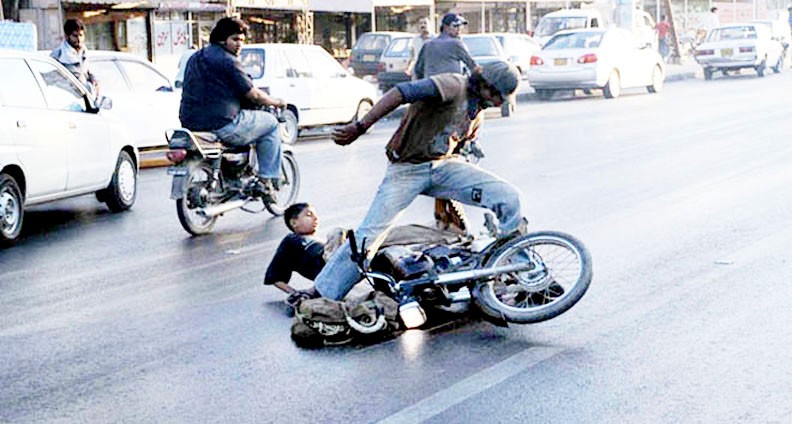
Safety is an attitude. Do you value your neighbour’s life as much as your own?

Driving in Lahore has never been easy. Not in my lifetime at least. Picture the open gutters on the roads, -- left, right, and centre; the rickshaws with drivers hitting an occasional car here and a push-cart there, and leaving a sinking feeling in the less accustomed gut, and a frank outburst of choicest Lahori invectives from all ‘concerned’ in their wake; bikes carrying a bunch of eight(!), cars whose tyres have never been replaced… and so on.
For a long time, I thought that Bund Road was so called because it was perpetually closed and that was way before the Orange Train was foisted upon us.
Your pulse on The Mall, Hall Road, and Davis Rd is regulated by a monstrous sea of bikers. The weak at heart, I’m sure, seek deliverance from them! The bikes sure have given our middle class wheels and much-needed mobility, but the hoards of dodgy-quality two-wheelers that are churned out annually raises one pertinent question: Who would give civic sense to them bikers?
‘Lahori drivers,’ so to say, have a bit of an Afridi flare -- one moment they are cruising happily, the next they are on a stretcher in a 1122 ambulance (God save us all!). This is particularly true in ‘galli mohallas’ and that’s almost behind every main road now. Here, you are on your own. No Rescue 1122, no wardens; just utter chaos, and it only gets worse in the event of a shower. Try Makkah and Madina colonies, near the railway tracks in Cantonment area, for instance.
It’s not that cars are any lesser in number now. Cheap Japanese imports have given fancy-looking, fragile cars to the masses bored by gazillion-year-old Suzukis, Corollas, and Hondas. As a result, every first-year student now goes to college on a car while his grandfather could have barely afforded a cycle. The freshman barely knows how to drive and his car carries a bumper sticker that says everything from "It’s my mom’s prayers" to "Terror"; sometimes the jealous ‘friend’ peels off T of the Terror.
The error remains there till the next owner, perhaps.
To and back from schools, Canal Road, Ichhra, Mozang Chungi and almost all sectors of Johar Town are now filled with anxious, middle class parents who block three lines of the roads just so that their children do not have to walk two steps from the car.
Motorcycle rickshaws aka Qingqi are perhaps the most dangerous aspect of Pak-China cooperation. These death machines literally can kill instantly. Some models (of motorcycle rickshaws) were legalised by none other than the Supreme Court sometime back, but like so many other cases I fail to see how common sense prevailed in this matter as this contraption could never have a proper rearview mirror.
Anyway, step out of the house, and you find motorcycle rickshaws in scores. But they are not the only oddity in a city street already plagued by donkey carts, and pushcarts with beggars holding semi-naked kids doped on opium to invite a mixed reaction of revulsion and philanthropy -- you name it, and we’ve got it out on the roads.
The poor man’s companion Tonga is a rare sight now, mostly confined to the interior Lahore.
There are rules. But nobody gives a damn. All new good motorbikes in Pakistan come with rearview mirrors, but why do we never see them (on the bikes)? Because the buyers get these removed right at the showroom, at the time of delivery. This shows our approach to safety.
Let’s compare the situation with that in the developed world. Ralph Nader, a US political activist and author in the 1960s, wrote a seminal work on vehicular safety, titled ‘Unsafe at Any Speed,’ in which he argued that the American cars of the era were inherently unsafe and the manufacturers could in some cases save money by making design changes. The book led to a congressional hearing and, consequently, standards were improved.
In the developed world, safety standards are continuously updated, revised, and improved. An important development has been with regard to the seatbelts. Along with airbags, the seatbelts are said to save 50-55 per cent of the crash victims, according to a source.
Helmets have been around for almost a millennium. Biker helmets come in many shapes and sizes but the developed countries have strict quality codes implemented. Where do we stand? Sadly, nowhere. The Pakistan Standards and Quality Control Authority website does not offer results for standards for either motorcycle helmets or airbags. But they do have an essay competition and wallpapers for site visitors.
Small cars made in Pakistan are basically based on the Japanese technology invented in the 1970s. Back then, safety standards were next to non-existent. These small cars usually split into two upon forceful impact with deadly consequences for those inside. Internationally, the producers would face multibillion dollar claims of compensation if such poor and antiquated engineering was sold as new.
Safety is an attitude. Do you value your neighbour’s life as much as your own? Is it really that hard for you to avoid a proper helmet? Would buckling up in the passenger seat be really very difficult? Could the government pass tough safety rules and regulations as easily it passes petroleum quotas? Think about it, at least while you are traversing some dug-up, perpetually blocked road of this city of myriad underpasses, overhead bridges, and never-ending YDA protests. You sure will have a lot of time to reflect on the situation!